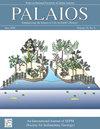GASTROPOD DRILLING PREDATION IN THE UPPER JURASSIC OF KUTCH, INDIA
IF 1.5
4区 地球科学
Q2 GEOLOGY
引用次数: 4
Abstract
Abstract: Gastropod drillholes on prey shells provide an opportunity to test the importance of predation in an evolutionary context. Although records of drilling predation are widespread across the Phanerozoic, the temporal distribution and relative importance of this mode of predation is still controversial. Further, some studies indicate a decline of drilling predation in the Mesozoic but other studies do not. In this study, we present a new dataset of gastropod drilling predation on Kimmeridgian and Tithonian bivalves of Kutch, India. Our study suggests that drilling was one of the prevailing modes of predation in the Upper Jurassic of Kutch with strongly variable intensities, ranging from 2% in the Kimmeridgian Seebachia to 26% in the Tithonian Pinna. A significant, albeit small, increase in drilling intensity from the Kimmeridgian to the Tithonian assemblages is associated with a change in relative sea-level and depositional environment. The morphology of drillholes and recent discovery of body fossils from the same stratigraphic units suggest naticid gastropods as the most likely drillers. A literature survey, along with previously collected specimen from the Jurassic of Kutch, reveals a more complex history of drilling predation than previously assumed.印度kutch上侏罗世腹足类动物的钻探捕食
摘要:腹足类动物在猎物外壳上的钻孔为检验捕食在进化背景下的重要性提供了机会。尽管钻食捕食的记录在显生宙广泛存在,但这种捕食模式的时间分布和相对重要性仍然存在争议。此外,一些研究表明,中生代的钻探捕食性有所下降,但其他研究则不然。在这项研究中,我们提出了一个关于印度库奇的Kimmeridian和Tithonia双壳类腹足类钻食捕食的新数据集。我们的研究表明,钻探是库奇上侏罗纪的主要捕食模式之一,强度变化很大,从Kimmeridian Seebachia的2%到Tithonian Pinna的26%不等。从Kimmeridian到Tithonia组合的钻探强度显著增加,尽管幅度很小,但与相对海平面和沉积环境的变化有关。钻孔的形态和最近发现的同一地层单元的身体化石表明,腹足类是最有可能的钻孔者。一项文献调查,以及之前从库奇侏罗纪采集的标本,揭示了比之前假设的更复杂的钻探捕食历史。
本文章由计算机程序翻译,如有差异,请以英文原文为准。
求助全文
约1分钟内获得全文
求助全文
来源期刊

Palaios
地学-地质学
CiteScore
2.80
自引率
12.50%
发文量
40
审稿时长
6 months
期刊介绍:
PALAIOS is a monthly journal, founded in 1986, dedicated to emphasizing the impact of life on Earth''s history as recorded in the paleontological and sedimentological records. PALAIOS disseminates information to an international spectrum of geologists and biologists interested in a broad range of topics, including, but not limited to, biogeochemistry, ichnology, paleoclimatology, paleoecology, paleoceanography, sedimentology, stratigraphy, geomicrobiology, paleobiogeochemistry, and astrobiology.
PALAIOS publishes original papers that emphasize using paleontology to answer important geological and biological questions that further our understanding of Earth history. Accordingly, manuscripts whose subject matter and conclusions have broader geologic implications are much more likely to be selected for publication. Given that the purpose of PALAIOS is to generate enthusiasm for paleontology among a broad spectrum of readers, the editors request the following: titles that generate immediate interest; abstracts that emphasize important conclusions; illustrations of professional caliber used in place of words; and lively, yet scholarly, text.
 求助内容:
求助内容: 应助结果提醒方式:
应助结果提醒方式:


